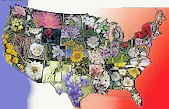
Oklahoma Symbols
Oklahoma State Floral Emblem
Mistletoe

(Phoradendron serotinum)
Adopted in 1893.
Mistletoe, (Phoradendron seotinum,) is the oldest of Oklahoma's symbols, adopted first in 1893 as Oklahoma official state floral emblem, 14 years before statehood. Its greenery in the harsh winter months symbolizes the perseverance of early settlers. The colors of the foliage of mistletoe and its berries, green and white, are the state colors of Oklahoma. Mistletoe grows on trees throughout the state and is particularly common in the southern regions of Oklahoma. The dark green leaves and white berries show up brightly during the fall and winter in trees that have shed their own leaves.
Oklahoma Floral Emblem: Mistletoe

. Mistletoe grows on trees throughout the state and is particularly bountiful in the southern regions of Oklahoma. The dark green leaves and white berries show up brightly during the fall and winter in trees that have shed their own leaves.
Mistletoes are a group of vascular, flowering plants that parasitize stems of trees and shrubs. There are 700-1400 species (depending who you ask) of mistletoe worldwide found in the Viscaceae and Loranthaceae families, located mainly in tropical and subtropical regions of the world. Even the family has several synonyms. Renamed by our own Dr. James Reveal as Phoradendron leucarpum (Johnston and Reveal), American mistletoe was previously know as P. serotinum, P. flavescens. Phoradendron has a wide geographic distribution and is found in the US from New Jersey to Florida to Texas. It has a broad host range and parasitizes mostly hardwoods.

Two genera of mistletoes grow in the United States: the "dwarf mistletoes" (genus Arceuthobium),and the "true mistletoes" (genus Phoradendron). An introduced mistletoe, the European Viscum album, has been found only in northern California--the apple growing region around Sebastopol and Santa Rosa. This mistletoe was presumably brought into this area inadvertently in the early 1900's on apple stock from Europe. Since then, it has spread over about a 16 square mile area, and is found on at least 20 other native and introduced hardwood tree and shrub species.
This family is characterized by semiparasitic plants, attached to trees or shrubs by haustoria, lacking ordinary roots, but having green (chlorophyllous) leaves and stems; leaves: opposite; flowers: inconspicuous; ovary: inferior; stamens: as many as and opposite the perianth-lobes.
The mistletoes are green, flowering plants that require a living host. Some are rather specific and grow on only a single genus of tree; others
occur on a wide range of hardwood species. Even though they are completely parasitic, they do manufacture much of their own food materials by photosynthesis
and in general require only water and mineral elements from the host plant. In the absence of the green aerial portions of the mistletoe plant, how
ever, the root system of the parasite can utilize host nutrients and remain alive within an infected branch for many years. The mistletoes are dioecoius
in that male and female flowers are borne on separate plants. Because male and female flowers are so similar in appearance it is difficult to tell
the sex of the plant unless fruit are present.
Mistletoe infections are spread mainly by birds (robins, bluebirds, thrushes, cedar waxwings, phainopeplas) that feed on the berries. The berries are
round, white to pink in color, occur in spikes and are about one-quarter inch in diameter. A berry usually holds a single seed surrounded by a sticky
pulp. Birds digest the pulp of the berry and excrete the living seed. By this means seeds are often deposited on susceptible trees. A viscous coating
and hair-like threads on the outer surface of the seeds attach excreted seeds firmly to tree branches. Upon germinating, the growing radicle becomes
tightly pressed to the branch surface. Young or small trees are seldom infected by mistletoe. In nearly all cases, initial infection occurs on larger
or older trees because birds prefer to perch in the tops of taller trees. Severe buildup of mistletoe often occurs within an infected tree because
birds are attracted to and may spend prolonged periods feeding on the mistletoe berries.
Infection takes place by means of a specialized, penetrating structure that forces its way through the bark and into the living host tissues. Once infection has occurred, the root system of the parasite grows within the branch. The aerial shoot system begins to develop shortly after the root system is well established. Often several years are required after infection for a new seed bearing plant to develop. The parasite usually does not spread rapidly, but once a plant is established, the root system gradually extends up and down the branch. Defoliation or destruction of the aerial portion does not kill the mistletoe. New shoots may be produced from the root system or the parasite may survive and grow entirely within the infected host tissues. Not until the tree dies, or the infected portion dies or is removed, is the mistletoe killed.
The mistletoes are rather intolerant of cold and near their northern limits aerial shoots are frequently killed by low winter temperatures
Mistletoe a controversial choice for Oklahoma state flower
Alfalfa, forget-me-nots, roses were all discussed before mistletoe became Oklahoma's floral emblem.
BY MARY PHILLIPS mphillips@opubco.com - Published: June 11, 2012
For 114 years, Oklahoma's state flower was the mistletoe.
But it was always a controversial choice.
In February 1893, while the 2nd Territorial Legislature met in Guthrie, Rep. John A. Wimberly introduced the bill to designate mistletoe as the official
floral emblem.
Photo - The mistletoe is Oklahoma's state floral emblem. PHOTO PROVIDED
The mistletoe is Oklahoma's state floral emblem. PHOTO PROVIDED
The Women's Congress of the Columbian World Exposition held in Chicago in 1893 had proposed that the states should consider selecting floral emblems
to represent their state at the exposition. While Oklahoma was not a state, the Oklahoma Pavilion at the exposition, also known as the Chicago World's
Fair, promoted the territory to exposition visitors.
Wimberly was the youngest member of the House of Representatives and it was he who, according to The Oklahoman on April 19, 1925, suggested "one
of the most interesting traditions."
"One day the question of the state flower was brought up. Everything from daisies to American Beauty roses was suggested.
A representative from the southern part of the Territory wanted forget-me-nots. "That's a good name for a state flower, and it's a pretty flower
too,"he said.
"Mr. Wimberly remembered how hard the previous winter had been and that when settlers had died and there were no flowers to put on the graves: "the
only thing in the whole country with a bit of color was mistletoe."
So it was adopted as the new territory's floral emblem.
"Years later when Oklahoma became a state, members of the constitutional convention carried the old territorial flower over into statehood, thus
confirming what has since become one of Oklahoma's oldest traditions."
Every few years after it seemed someone would propose a change, it would be discussed and mistletoe would remain.
The sweet pea, yucca and the cowboy rose (not a rose but a part of the mallow family), were among those proposed, but probably the most unusual was
the alfalfa blossom.
Before we were even a state, in 1906, William H. Murray stated his preference for alfalfa in a letter to the editor of The Oklahoman:
"Who, indeed, would desire to adopt for a state flower, a parasite?
Let greater Oklahoma be known as the "Alfalfa State."
In an editorial in The Oklahoman for June 17, 1912, the newspaper came out in support of alfalfa as the state flower:
"Now that Oklahoma has become known as the marvelous alfalfa state, why not use the alfalfa blossom as the state flower?"
"The alfalfa blossoms are pretty; they enrich the scenery, added to the artistic part, alfalfa, is the mortgage lifter of Oklahoma. It is the crop
which brings riches to the state; it is a crop which means more to the future than any other crop."
"Alfalfa blossom - the state flower. It should be adopted"
The hardy little mistletoe stood firm from 1890 until 2004 when Gov. Brad Henry signed a bill into law making the Oklahoma Rose our official state
flower. The mistletoe remains the state floral emblem.
The Oklahoma Statutes
The law designating the mistletoe as the official Oklahoma state floral emblem is found in the Oklahoma Statutes, Title 25, Chapter 3, Section 25-92.
The Oklahoma Statutes
TITLE 25. Definitions and General Provisions.
Chapter 3 - State Emblems and Honorary Positions.
SECTION 25-92.
Title 25. Definitions and General Provisions
Chapter 3.- State Flag and Other Emblem
§92. State floral emblem.
The mistletoe shall be the floral emblem of the state.
R.L.1910, § 2952.
Taxonomic Hierarchy: Mistletoe
Kingdom: Plantae - Plants
Subkingdom: Tracheobionta - Vascular plants
Superdivision: Spermatophyta - Seed plants
Division: Magnoliophyta - Flowering plants
Class: Magnoliopsida - Dicotyledons
Subclass: Rosidae -
Order: Santalales -
Family: Viscaceae - Christmas Mistletoe family
Genus: Phoradendron Nutt. - mistletoe
Species: Phoradendron tomentosum (DC.) Engelm.
ex Gray - Christmas mistletoe
State Floral Emblems







